Economics for Business: Supply Side Policies, Growth, and Challenges
VerifiedAdded on 2021/01/01
|11
|2953
|276
Report
AI Summary
This report provides a comprehensive overview of supply-side macroeconomic policies, differentiating between market-oriented and interventionist approaches. It explores the objectives of supply-side policies, such as fostering economic growth, increasing employment, and controlling inflation, emphasizing the importance of enterprise, technology, efficiency, and incentives. The report delves into key economic equations, including aggregate production functions and saving equations, to illustrate the dynamics of economic growth. It also examines the impact of successful supply-side policies, including their effects on inflation, unemployment, and trade balances. Furthermore, the report addresses challenges faced by the UK government and proposes various policies related to labor markets, capital markets, entrepreneurship, and education. The analysis includes examples of free market-oriented and interventionist policies, such as privatization, deregulation, tax cuts, and investments in human capital, to provide a well-rounded understanding of the subject. The report also provides diagrams to help understand the impact of supply side policies on aggregate supply.
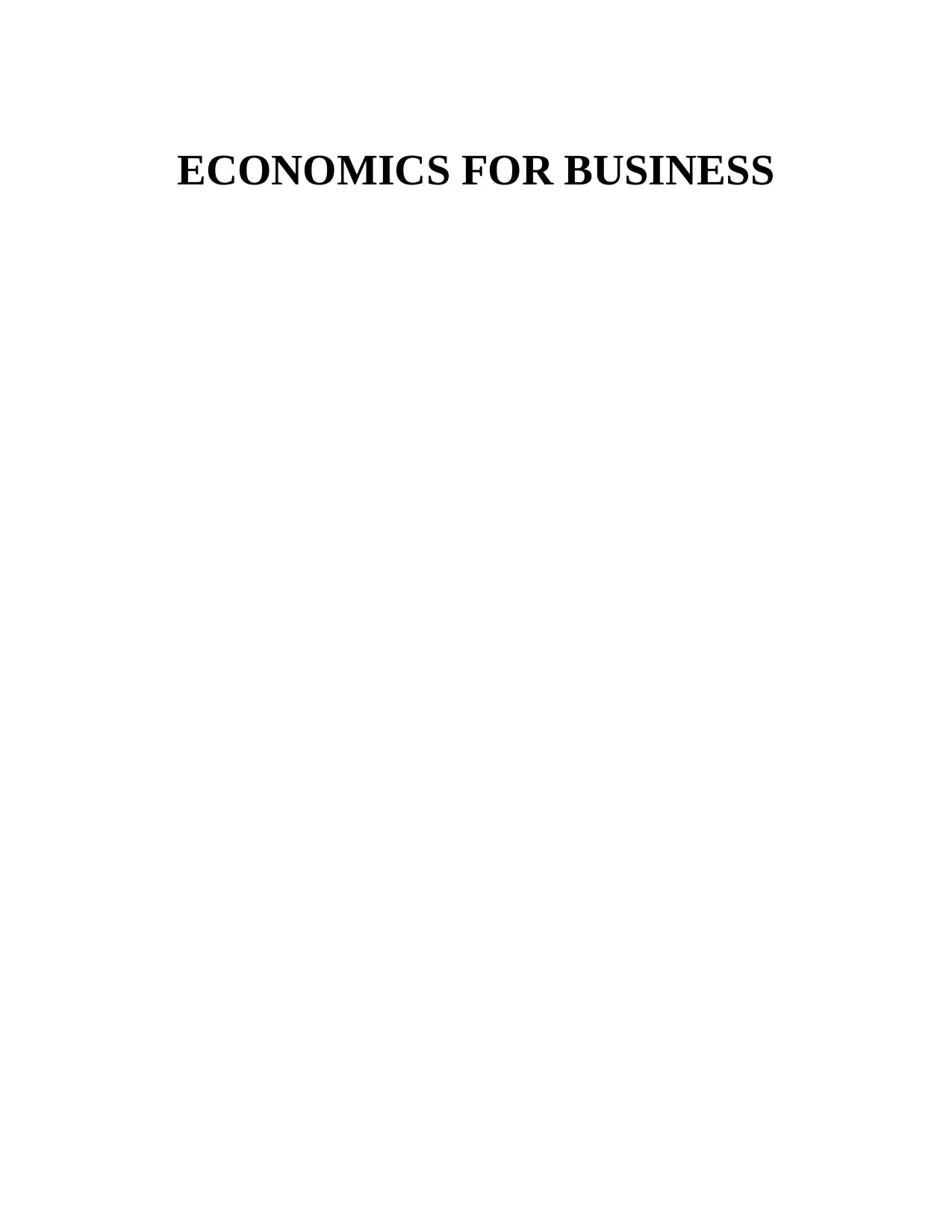
ECONOMICS FOR BUSINESS
Paraphrase This Document
Need a fresh take? Get an instant paraphrase of this document with our AI Paraphraser
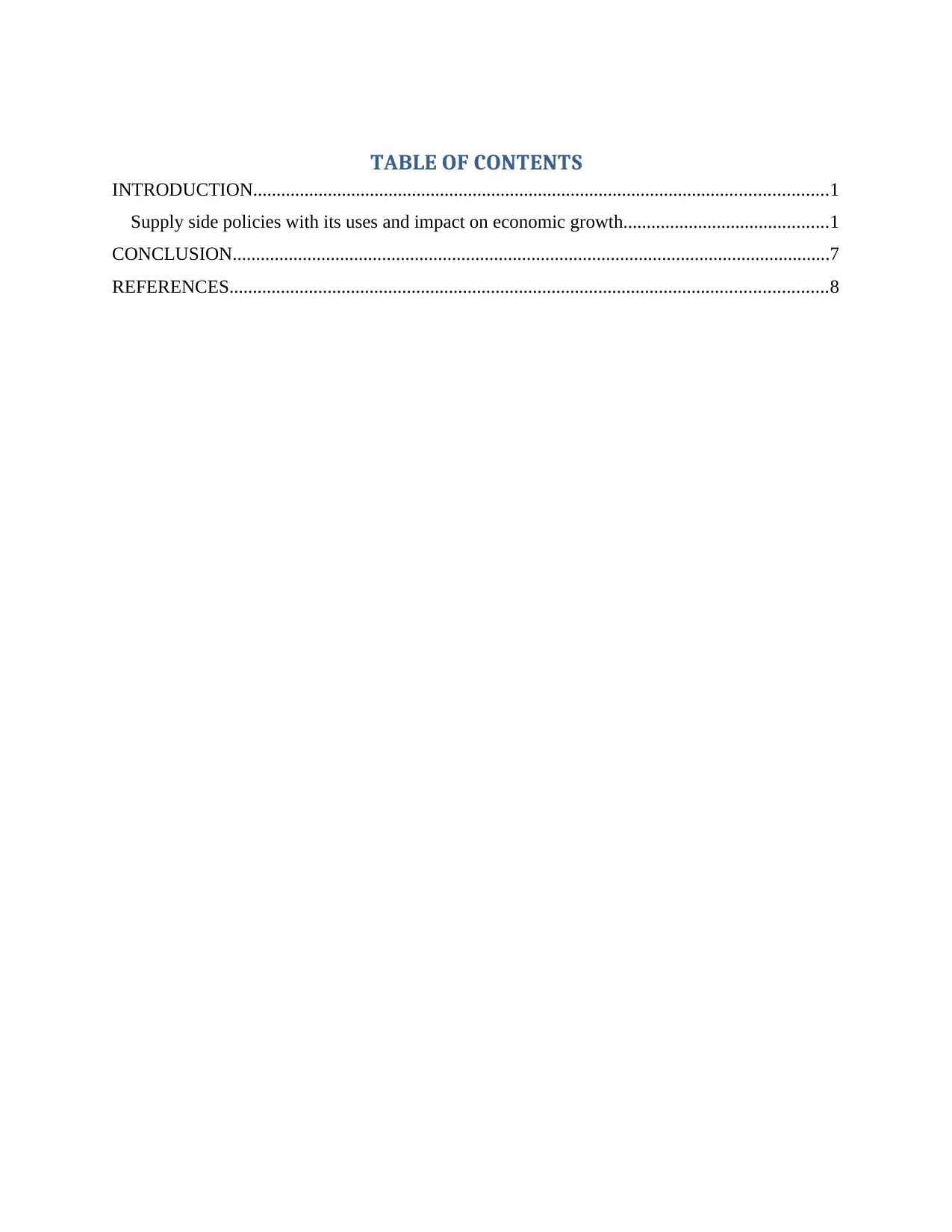
TABLE OF CONTENTS
INTRODUCTION...........................................................................................................................1
Supply side policies with its uses and impact on economic growth............................................1
CONCLUSION................................................................................................................................7
REFERENCES................................................................................................................................8
INTRODUCTION...........................................................................................................................1
Supply side policies with its uses and impact on economic growth............................................1
CONCLUSION................................................................................................................................7
REFERENCES................................................................................................................................8
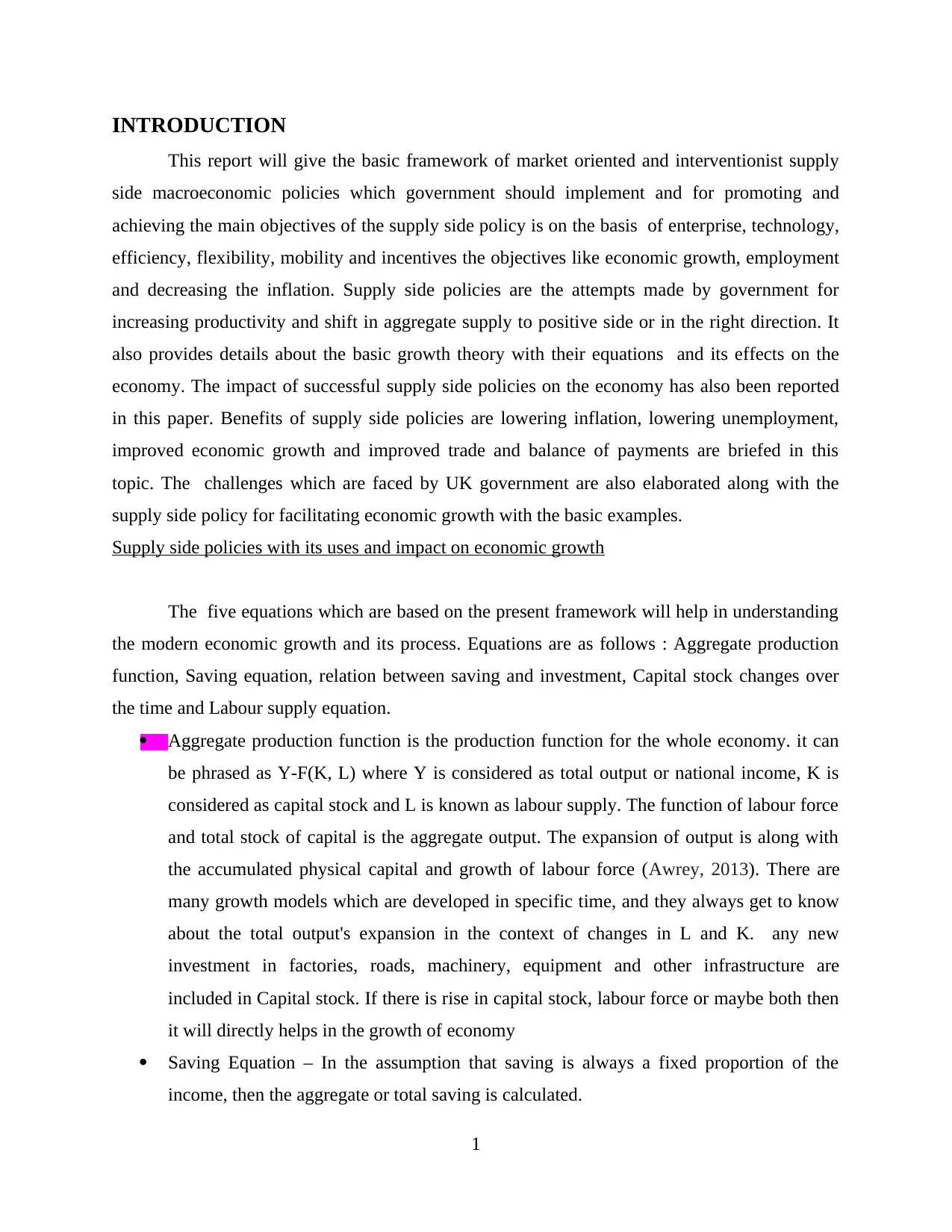
INTRODUCTION
This report will give the basic framework of market oriented and interventionist supply
side macroeconomic policies which government should implement and for promoting and
achieving the main objectives of the supply side policy is on the basis of enterprise, technology,
efficiency, flexibility, mobility and incentives the objectives like economic growth, employment
and decreasing the inflation. Supply side policies are the attempts made by government for
increasing productivity and shift in aggregate supply to positive side or in the right direction. It
also provides details about the basic growth theory with their equations and its effects on the
economy. The impact of successful supply side policies on the economy has also been reported
in this paper. Benefits of supply side policies are lowering inflation, lowering unemployment,
improved economic growth and improved trade and balance of payments are briefed in this
topic. The challenges which are faced by UK government are also elaborated along with the
supply side policy for facilitating economic growth with the basic examples.
Supply side policies with its uses and impact on economic growth
The five equations which are based on the present framework will help in understanding
the modern economic growth and its process. Equations are as follows : Aggregate production
function, Saving equation, relation between saving and investment, Capital stock changes over
the time and Labour supply equation.
Aggregate production function is the production function for the whole economy. it can
be phrased as Y-F(K, L) where Y is considered as total output or national income, K is
considered as capital stock and L is known as labour supply. The function of labour force
and total stock of capital is the aggregate output. The expansion of output is along with
the accumulated physical capital and growth of labour force (Awrey, 2013). There are
many growth models which are developed in specific time, and they always get to know
about the total output's expansion in the context of changes in L and K. any new
investment in factories, roads, machinery, equipment and other infrastructure are
included in Capital stock. If there is rise in capital stock, labour force or maybe both then
it will directly helps in the growth of economy
Saving Equation – In the assumption that saving is always a fixed proportion of the
income, then the aggregate or total saving is calculated.
1
This report will give the basic framework of market oriented and interventionist supply
side macroeconomic policies which government should implement and for promoting and
achieving the main objectives of the supply side policy is on the basis of enterprise, technology,
efficiency, flexibility, mobility and incentives the objectives like economic growth, employment
and decreasing the inflation. Supply side policies are the attempts made by government for
increasing productivity and shift in aggregate supply to positive side or in the right direction. It
also provides details about the basic growth theory with their equations and its effects on the
economy. The impact of successful supply side policies on the economy has also been reported
in this paper. Benefits of supply side policies are lowering inflation, lowering unemployment,
improved economic growth and improved trade and balance of payments are briefed in this
topic. The challenges which are faced by UK government are also elaborated along with the
supply side policy for facilitating economic growth with the basic examples.
Supply side policies with its uses and impact on economic growth
The five equations which are based on the present framework will help in understanding
the modern economic growth and its process. Equations are as follows : Aggregate production
function, Saving equation, relation between saving and investment, Capital stock changes over
the time and Labour supply equation.
Aggregate production function is the production function for the whole economy. it can
be phrased as Y-F(K, L) where Y is considered as total output or national income, K is
considered as capital stock and L is known as labour supply. The function of labour force
and total stock of capital is the aggregate output. The expansion of output is along with
the accumulated physical capital and growth of labour force (Awrey, 2013). There are
many growth models which are developed in specific time, and they always get to know
about the total output's expansion in the context of changes in L and K. any new
investment in factories, roads, machinery, equipment and other infrastructure are
included in Capital stock. If there is rise in capital stock, labour force or maybe both then
it will directly helps in the growth of economy
Saving Equation – In the assumption that saving is always a fixed proportion of the
income, then the aggregate or total saving is calculated.
1
⊘ This is a preview!⊘
Do you want full access?
Subscribe today to unlock all pages.

Trusted by 1+ million students worldwide
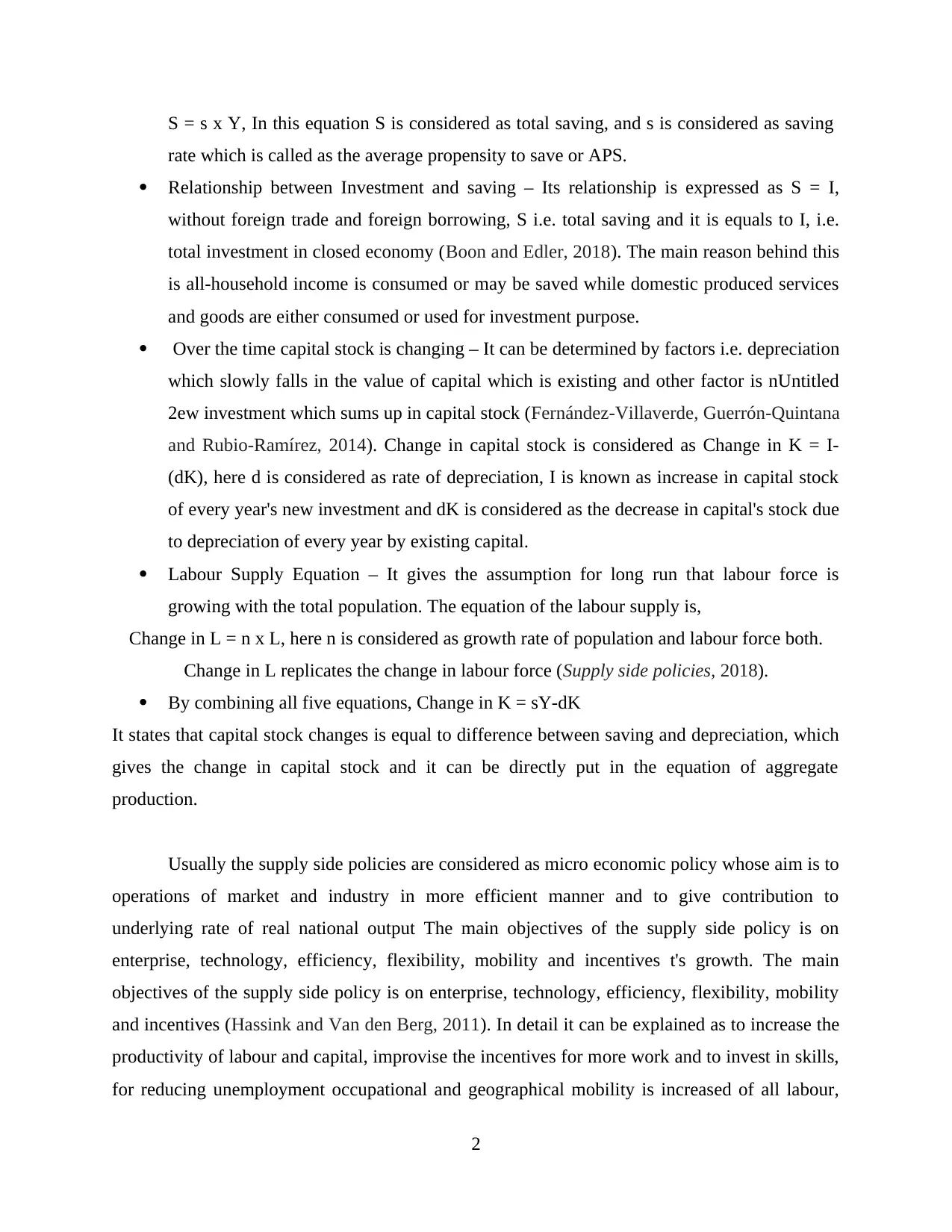
S = s x Y, In this equation S is considered as total saving, and s is considered as saving
rate which is called as the average propensity to save or APS.
Relationship between Investment and saving – Its relationship is expressed as S = I,
without foreign trade and foreign borrowing, S i.e. total saving and it is equals to I, i.e.
total investment in closed economy (Boon and Edler, 2018). The main reason behind this
is all-household income is consumed or may be saved while domestic produced services
and goods are either consumed or used for investment purpose.
Over the time capital stock is changing – It can be determined by factors i.e. depreciation
which slowly falls in the value of capital which is existing and other factor is nUntitled
2ew investment which sums up in capital stock (Fernández-Villaverde, Guerrón-Quintana
and Rubio-Ramírez, 2014). Change in capital stock is considered as Change in K = I-
(dK), here d is considered as rate of depreciation, I is known as increase in capital stock
of every year's new investment and dK is considered as the decrease in capital's stock due
to depreciation of every year by existing capital.
Labour Supply Equation – It gives the assumption for long run that labour force is
growing with the total population. The equation of the labour supply is,
Change in L = n x L, here n is considered as growth rate of population and labour force both.
Change in L replicates the change in labour force (Supply side policies, 2018).
By combining all five equations, Change in K = sY-dK
It states that capital stock changes is equal to difference between saving and depreciation, which
gives the change in capital stock and it can be directly put in the equation of aggregate
production.
Usually the supply side policies are considered as micro economic policy whose aim is to
operations of market and industry in more efficient manner and to give contribution to
underlying rate of real national output The main objectives of the supply side policy is on
enterprise, technology, efficiency, flexibility, mobility and incentives t's growth. The main
objectives of the supply side policy is on enterprise, technology, efficiency, flexibility, mobility
and incentives (Hassink and Van den Berg, 2011). In detail it can be explained as to increase the
productivity of labour and capital, improvise the incentives for more work and to invest in skills,
for reducing unemployment occupational and geographical mobility is increased of all labour,
2
rate which is called as the average propensity to save or APS.
Relationship between Investment and saving – Its relationship is expressed as S = I,
without foreign trade and foreign borrowing, S i.e. total saving and it is equals to I, i.e.
total investment in closed economy (Boon and Edler, 2018). The main reason behind this
is all-household income is consumed or may be saved while domestic produced services
and goods are either consumed or used for investment purpose.
Over the time capital stock is changing – It can be determined by factors i.e. depreciation
which slowly falls in the value of capital which is existing and other factor is nUntitled
2ew investment which sums up in capital stock (Fernández-Villaverde, Guerrón-Quintana
and Rubio-Ramírez, 2014). Change in capital stock is considered as Change in K = I-
(dK), here d is considered as rate of depreciation, I is known as increase in capital stock
of every year's new investment and dK is considered as the decrease in capital's stock due
to depreciation of every year by existing capital.
Labour Supply Equation – It gives the assumption for long run that labour force is
growing with the total population. The equation of the labour supply is,
Change in L = n x L, here n is considered as growth rate of population and labour force both.
Change in L replicates the change in labour force (Supply side policies, 2018).
By combining all five equations, Change in K = sY-dK
It states that capital stock changes is equal to difference between saving and depreciation, which
gives the change in capital stock and it can be directly put in the equation of aggregate
production.
Usually the supply side policies are considered as micro economic policy whose aim is to
operations of market and industry in more efficient manner and to give contribution to
underlying rate of real national output The main objectives of the supply side policy is on
enterprise, technology, efficiency, flexibility, mobility and incentives t's growth. The main
objectives of the supply side policy is on enterprise, technology, efficiency, flexibility, mobility
and incentives (Hassink and Van den Berg, 2011). In detail it can be explained as to increase the
productivity of labour and capital, improvise the incentives for more work and to invest in skills,
for reducing unemployment occupational and geographical mobility is increased of all labour,
2
Paraphrase This Document
Need a fresh take? Get an instant paraphrase of this document with our AI Paraphraser
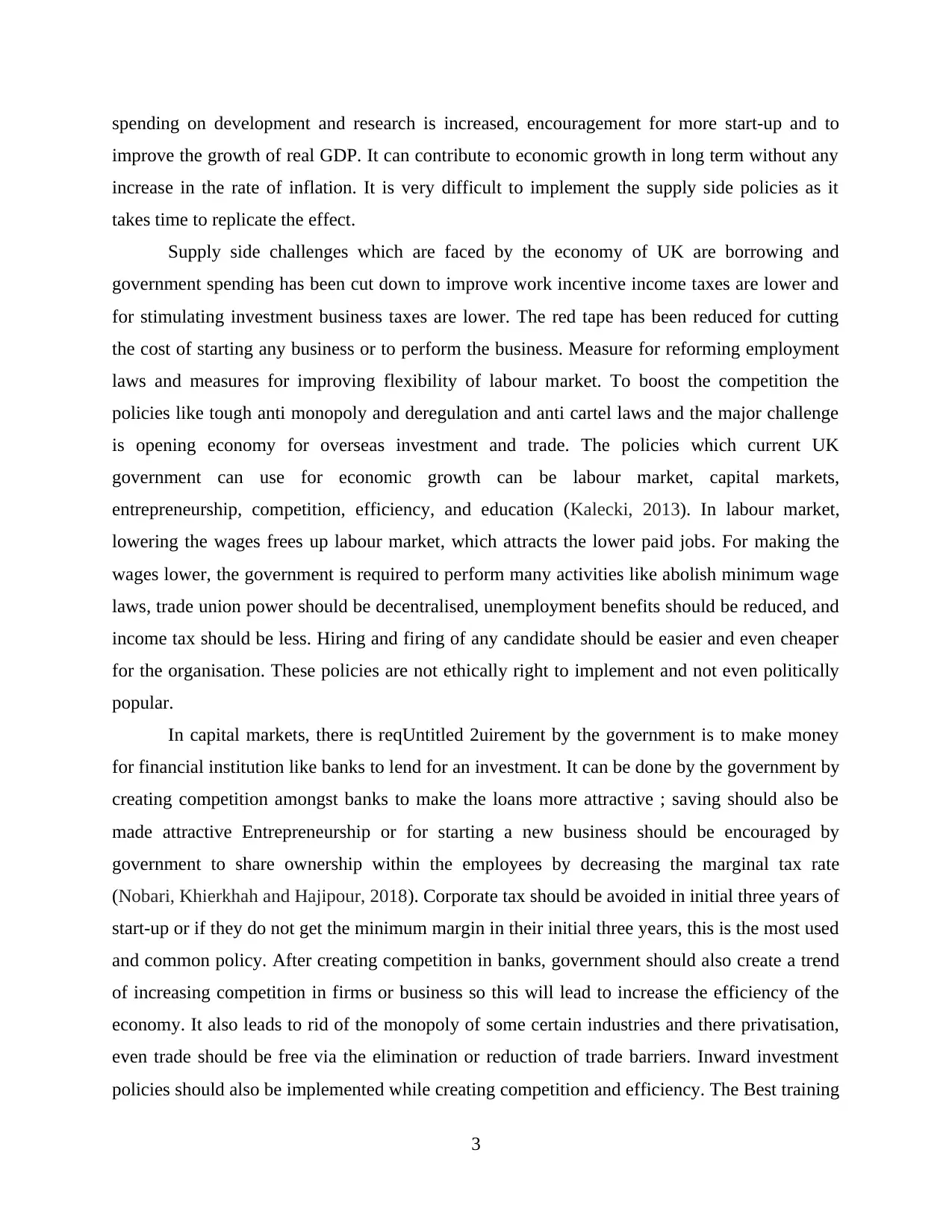
spending on development and research is increased, encouragement for more start-up and to
improve the growth of real GDP. It can contribute to economic growth in long term without any
increase in the rate of inflation. It is very difficult to implement the supply side policies as it
takes time to replicate the effect.
Supply side challenges which are faced by the economy of UK are borrowing and
government spending has been cut down to improve work incentive income taxes are lower and
for stimulating investment business taxes are lower. The red tape has been reduced for cutting
the cost of starting any business or to perform the business. Measure for reforming employment
laws and measures for improving flexibility of labour market. To boost the competition the
policies like tough anti monopoly and deregulation and anti cartel laws and the major challenge
is opening economy for overseas investment and trade. The policies which current UK
government can use for economic growth can be labour market, capital markets,
entrepreneurship, competition, efficiency, and education (Kalecki, 2013). In labour market,
lowering the wages frees up labour market, which attracts the lower paid jobs. For making the
wages lower, the government is required to perform many activities like abolish minimum wage
laws, trade union power should be decentralised, unemployment benefits should be reduced, and
income tax should be less. Hiring and firing of any candidate should be easier and even cheaper
for the organisation. These policies are not ethically right to implement and not even politically
popular.
In capital markets, there is reqUntitled 2uirement by the government is to make money
for financial institution like banks to lend for an investment. It can be done by the government by
creating competition amongst banks to make the loans more attractive ; saving should also be
made attractive Entrepreneurship or for starting a new business should be encouraged by
government to share ownership within the employees by decreasing the marginal tax rate
(Nobari, Khierkhah and Hajipour, 2018). Corporate tax should be avoided in initial three years of
start-up or if they do not get the minimum margin in their initial three years, this is the most used
and common policy. After creating competition in banks, government should also create a trend
of increasing competition in firms or business so this will lead to increase the efficiency of the
economy. It also leads to rid of the monopoly of some certain industries and there privatisation,
even trade should be free via the elimination or reduction of trade barriers. Inward investment
policies should also be implemented while creating competition and efficiency. The Best training
3
improve the growth of real GDP. It can contribute to economic growth in long term without any
increase in the rate of inflation. It is very difficult to implement the supply side policies as it
takes time to replicate the effect.
Supply side challenges which are faced by the economy of UK are borrowing and
government spending has been cut down to improve work incentive income taxes are lower and
for stimulating investment business taxes are lower. The red tape has been reduced for cutting
the cost of starting any business or to perform the business. Measure for reforming employment
laws and measures for improving flexibility of labour market. To boost the competition the
policies like tough anti monopoly and deregulation and anti cartel laws and the major challenge
is opening economy for overseas investment and trade. The policies which current UK
government can use for economic growth can be labour market, capital markets,
entrepreneurship, competition, efficiency, and education (Kalecki, 2013). In labour market,
lowering the wages frees up labour market, which attracts the lower paid jobs. For making the
wages lower, the government is required to perform many activities like abolish minimum wage
laws, trade union power should be decentralised, unemployment benefits should be reduced, and
income tax should be less. Hiring and firing of any candidate should be easier and even cheaper
for the organisation. These policies are not ethically right to implement and not even politically
popular.
In capital markets, there is reqUntitled 2uirement by the government is to make money
for financial institution like banks to lend for an investment. It can be done by the government by
creating competition amongst banks to make the loans more attractive ; saving should also be
made attractive Entrepreneurship or for starting a new business should be encouraged by
government to share ownership within the employees by decreasing the marginal tax rate
(Nobari, Khierkhah and Hajipour, 2018). Corporate tax should be avoided in initial three years of
start-up or if they do not get the minimum margin in their initial three years, this is the most used
and common policy. After creating competition in banks, government should also create a trend
of increasing competition in firms or business so this will lead to increase the efficiency of the
economy. It also leads to rid of the monopoly of some certain industries and there privatisation,
even trade should be free via the elimination or reduction of trade barriers. Inward investment
policies should also be implemented while creating competition and efficiency. The Best training
3
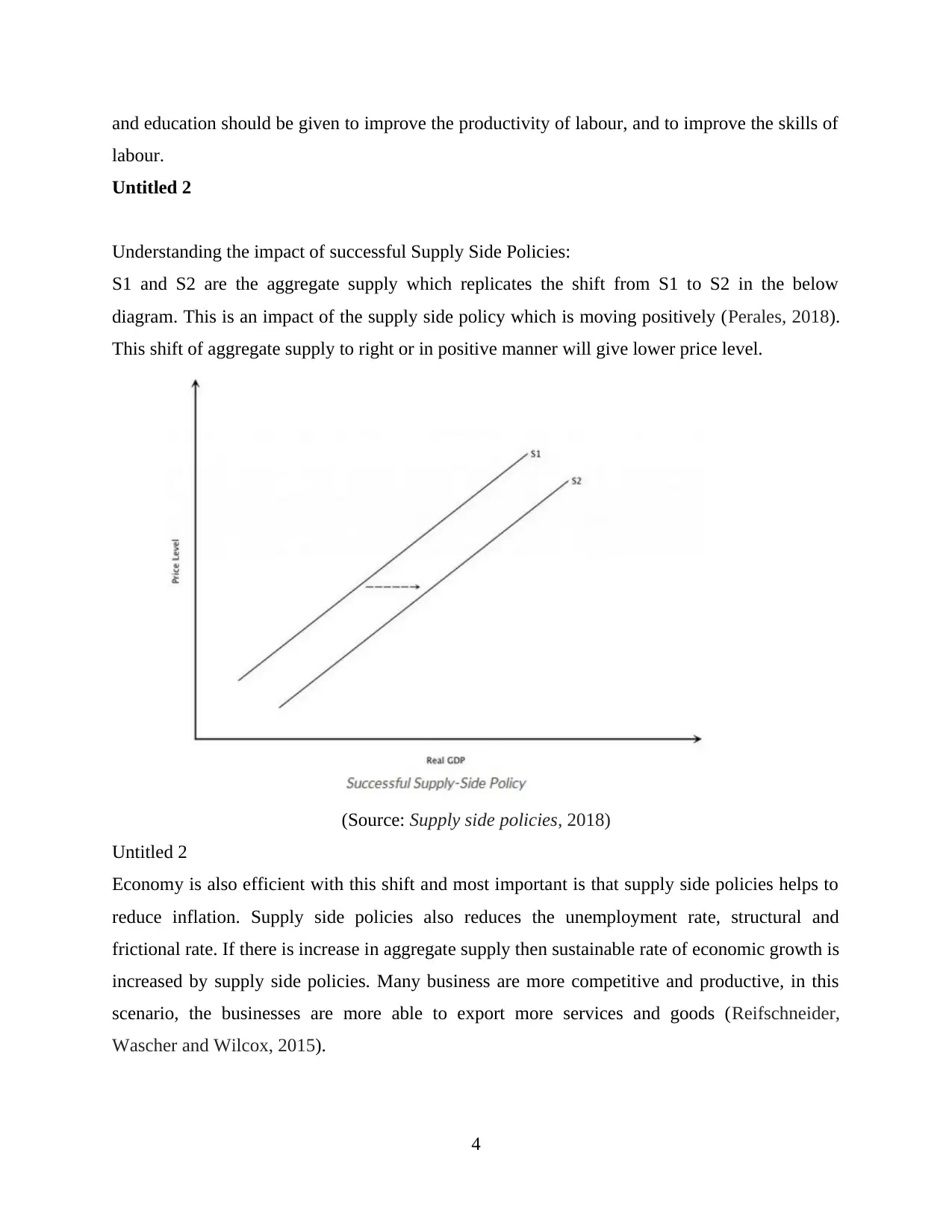
and education should be given to improve the productivity of labour, and to improve the skills of
labour.
Untitled 2
Understanding the impact of successful Supply Side Policies:
S1 and S2 are the aggregate supply which replicates the shift from S1 to S2 in the below
diagram. This is an impact of the supply side policy which is moving positively (Perales, 2018).
This shift of aggregate supply to right or in positive manner will give lower price level.
(Source: Supply side policies, 2018)
Untitled 2
Economy is also efficient with this shift and most important is that supply side policies helps to
reduce inflation. Supply side policies also reduces the unemployment rate, structural and
frictional rate. If there is increase in aggregate supply then sustainable rate of economic growth is
increased by supply side policies. Many business are more competitive and productive, in this
scenario, the businesses are more able to export more services and goods (Reifschneider,
Wascher and Wilcox, 2015).
4
labour.
Untitled 2
Understanding the impact of successful Supply Side Policies:
S1 and S2 are the aggregate supply which replicates the shift from S1 to S2 in the below
diagram. This is an impact of the supply side policy which is moving positively (Perales, 2018).
This shift of aggregate supply to right or in positive manner will give lower price level.
(Source: Supply side policies, 2018)
Untitled 2
Economy is also efficient with this shift and most important is that supply side policies helps to
reduce inflation. Supply side policies also reduces the unemployment rate, structural and
frictional rate. If there is increase in aggregate supply then sustainable rate of economic growth is
increased by supply side policies. Many business are more competitive and productive, in this
scenario, the businesses are more able to export more services and goods (Reifschneider,
Wascher and Wilcox, 2015).
4
⊘ This is a preview!⊘
Do you want full access?
Subscribe today to unlock all pages.

Trusted by 1+ million students worldwide
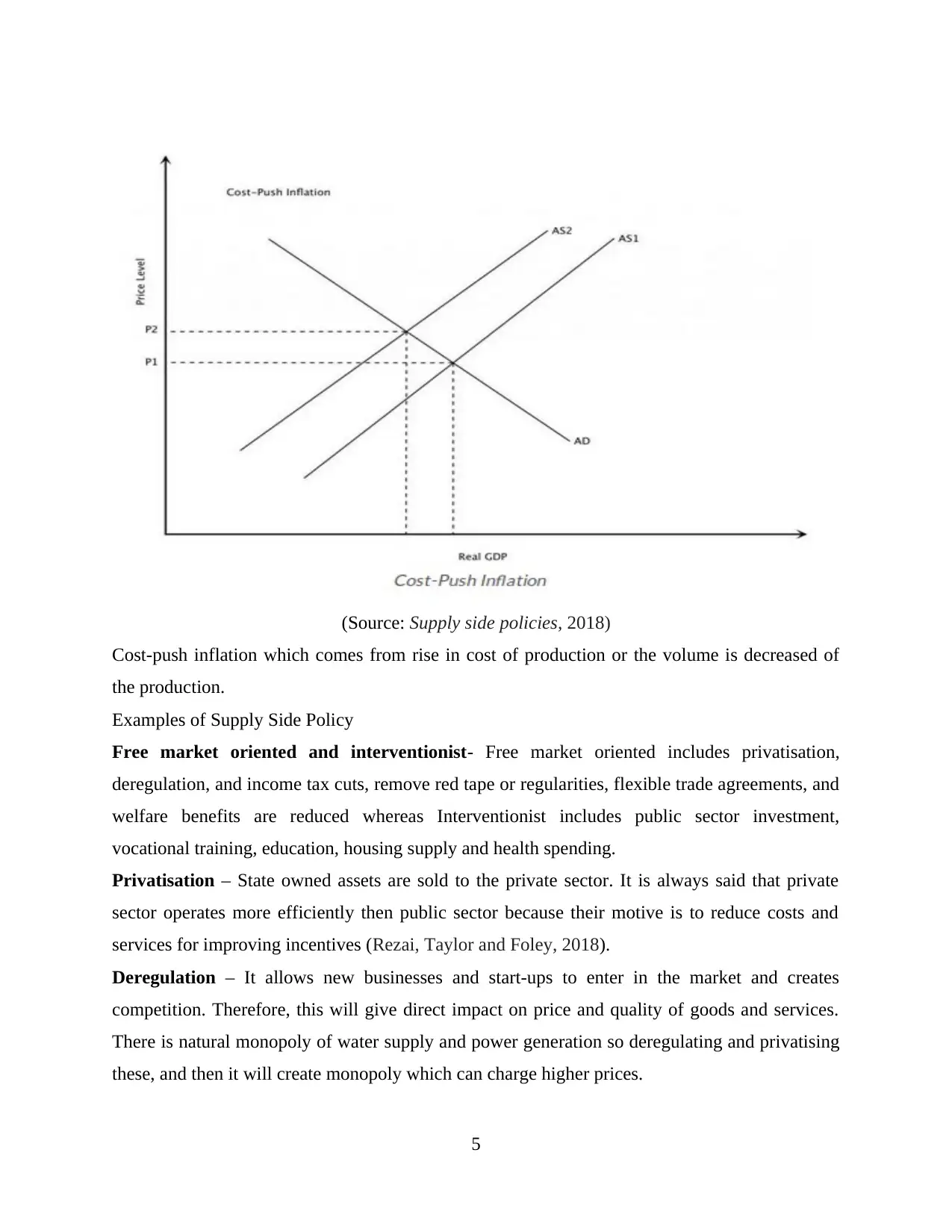
(Source: Supply side policies, 2018)
Cost-push inflation which comes from rise in cost of production or the volume is decreased of
the production.
Examples of Supply Side Policy
Free market oriented and interventionist- Free market oriented includes privatisation,
deregulation, and income tax cuts, remove red tape or regularities, flexible trade agreements, and
welfare benefits are reduced whereas Interventionist includes public sector investment,
vocational training, education, housing supply and health spending.
Privatisation – State owned assets are sold to the private sector. It is always said that private
sector operates more efficiently then public sector because their motive is to reduce costs and
services for improving incentives (Rezai, Taylor and Foley, 2018).
Deregulation – It allows new businesses and start-ups to enter in the market and creates
competition. Therefore, this will give direct impact on price and quality of goods and services.
There is natural monopoly of water supply and power generation so deregulating and privatising
these, and then it will create monopoly which can charge higher prices.
5
Cost-push inflation which comes from rise in cost of production or the volume is decreased of
the production.
Examples of Supply Side Policy
Free market oriented and interventionist- Free market oriented includes privatisation,
deregulation, and income tax cuts, remove red tape or regularities, flexible trade agreements, and
welfare benefits are reduced whereas Interventionist includes public sector investment,
vocational training, education, housing supply and health spending.
Privatisation – State owned assets are sold to the private sector. It is always said that private
sector operates more efficiently then public sector because their motive is to reduce costs and
services for improving incentives (Rezai, Taylor and Foley, 2018).
Deregulation – It allows new businesses and start-ups to enter in the market and creates
competition. Therefore, this will give direct impact on price and quality of goods and services.
There is natural monopoly of water supply and power generation so deregulating and privatising
these, and then it will create monopoly which can charge higher prices.
5
Paraphrase This Document
Need a fresh take? Get an instant paraphrase of this document with our AI Paraphraser
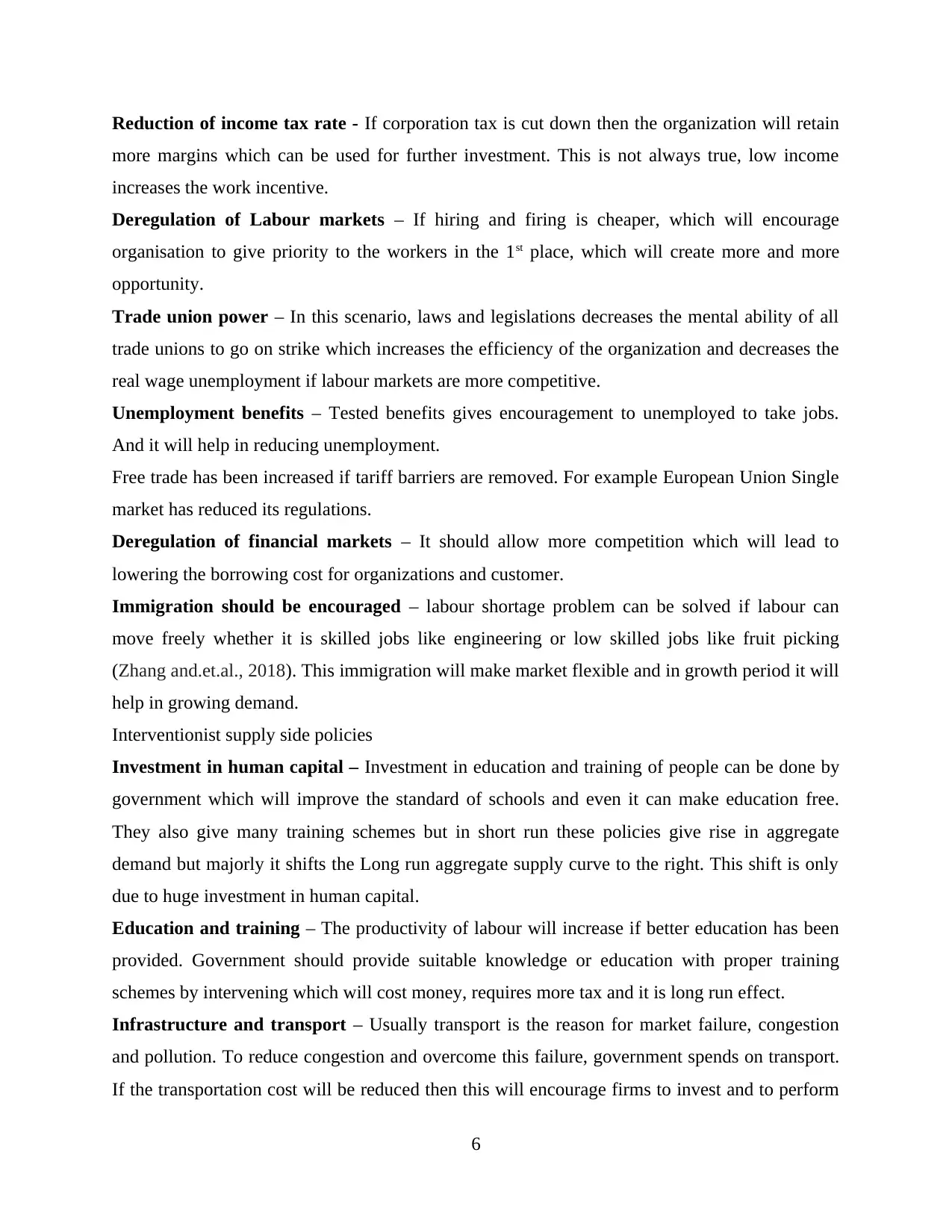
Reduction of income tax rate - If corporation tax is cut down then the organization will retain
more margins which can be used for further investment. This is not always true, low income
increases the work incentive.
Deregulation of Labour markets – If hiring and firing is cheaper, which will encourage
organisation to give priority to the workers in the 1st place, which will create more and more
opportunity.
Trade union power – In this scenario, laws and legislations decreases the mental ability of all
trade unions to go on strike which increases the efficiency of the organization and decreases the
real wage unemployment if labour markets are more competitive.
Unemployment benefits – Tested benefits gives encouragement to unemployed to take jobs.
And it will help in reducing unemployment.
Free trade has been increased if tariff barriers are removed. For example European Union Single
market has reduced its regulations.
Deregulation of financial markets – It should allow more competition which will lead to
lowering the borrowing cost for organizations and customer.
Immigration should be encouraged – labour shortage problem can be solved if labour can
move freely whether it is skilled jobs like engineering or low skilled jobs like fruit picking
(Zhang and.et.al., 2018). This immigration will make market flexible and in growth period it will
help in growing demand.
Interventionist supply side policies
Investment in human capital – Investment in education and training of people can be done by
government which will improve the standard of schools and even it can make education free.
They also give many training schemes but in short run these policies give rise in aggregate
demand but majorly it shifts the Long run aggregate supply curve to the right. This shift is only
due to huge investment in human capital.
Education and training – The productivity of labour will increase if better education has been
provided. Government should provide suitable knowledge or education with proper training
schemes by intervening which will cost money, requires more tax and it is long run effect.
Infrastructure and transport – Usually transport is the reason for market failure, congestion
and pollution. To reduce congestion and overcome this failure, government spends on transport.
If the transportation cost will be reduced then this will encourage firms to invest and to perform
6
more margins which can be used for further investment. This is not always true, low income
increases the work incentive.
Deregulation of Labour markets – If hiring and firing is cheaper, which will encourage
organisation to give priority to the workers in the 1st place, which will create more and more
opportunity.
Trade union power – In this scenario, laws and legislations decreases the mental ability of all
trade unions to go on strike which increases the efficiency of the organization and decreases the
real wage unemployment if labour markets are more competitive.
Unemployment benefits – Tested benefits gives encouragement to unemployed to take jobs.
And it will help in reducing unemployment.
Free trade has been increased if tariff barriers are removed. For example European Union Single
market has reduced its regulations.
Deregulation of financial markets – It should allow more competition which will lead to
lowering the borrowing cost for organizations and customer.
Immigration should be encouraged – labour shortage problem can be solved if labour can
move freely whether it is skilled jobs like engineering or low skilled jobs like fruit picking
(Zhang and.et.al., 2018). This immigration will make market flexible and in growth period it will
help in growing demand.
Interventionist supply side policies
Investment in human capital – Investment in education and training of people can be done by
government which will improve the standard of schools and even it can make education free.
They also give many training schemes but in short run these policies give rise in aggregate
demand but majorly it shifts the Long run aggregate supply curve to the right. This shift is only
due to huge investment in human capital.
Education and training – The productivity of labour will increase if better education has been
provided. Government should provide suitable knowledge or education with proper training
schemes by intervening which will cost money, requires more tax and it is long run effect.
Infrastructure and transport – Usually transport is the reason for market failure, congestion
and pollution. To reduce congestion and overcome this failure, government spends on transport.
If the transportation cost will be reduced then this will encourage firms to invest and to perform
6
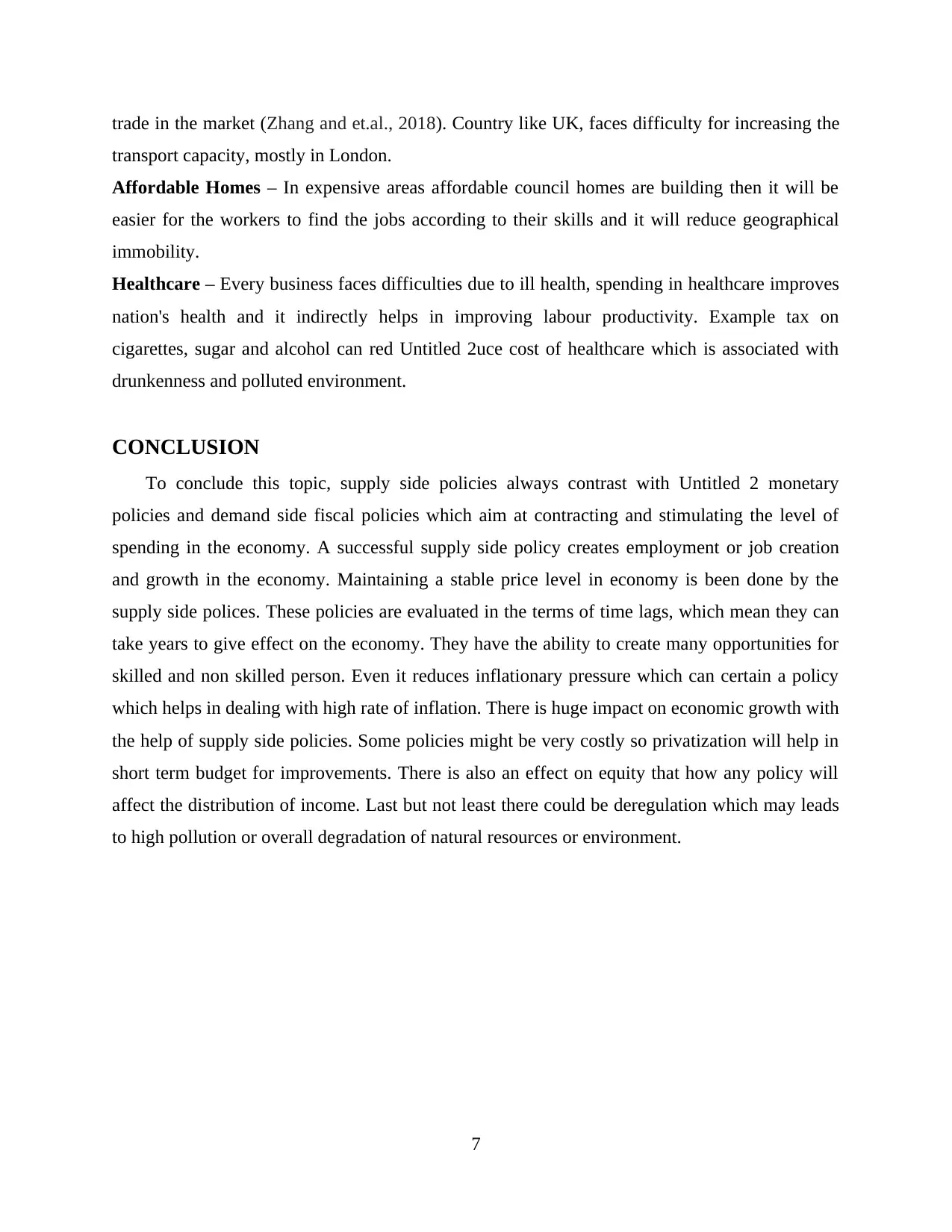
trade in the market (Zhang and et.al., 2018). Country like UK, faces difficulty for increasing the
transport capacity, mostly in London.
Affordable Homes – In expensive areas affordable council homes are building then it will be
easier for the workers to find the jobs according to their skills and it will reduce geographical
immobility.
Healthcare – Every business faces difficulties due to ill health, spending in healthcare improves
nation's health and it indirectly helps in improving labour productivity. Example tax on
cigarettes, sugar and alcohol can red Untitled 2uce cost of healthcare which is associated with
drunkenness and polluted environment.
CONCLUSION
To conclude this topic, supply side policies always contrast with Untitled 2 monetary
policies and demand side fiscal policies which aim at contracting and stimulating the level of
spending in the economy. A successful supply side policy creates employment or job creation
and growth in the economy. Maintaining a stable price level in economy is been done by the
supply side polices. These policies are evaluated in the terms of time lags, which mean they can
take years to give effect on the economy. They have the ability to create many opportunities for
skilled and non skilled person. Even it reduces inflationary pressure which can certain a policy
which helps in dealing with high rate of inflation. There is huge impact on economic growth with
the help of supply side policies. Some policies might be very costly so privatization will help in
short term budget for improvements. There is also an effect on equity that how any policy will
affect the distribution of income. Last but not least there could be deregulation which may leads
to high pollution or overall degradation of natural resources or environment.
7
transport capacity, mostly in London.
Affordable Homes – In expensive areas affordable council homes are building then it will be
easier for the workers to find the jobs according to their skills and it will reduce geographical
immobility.
Healthcare – Every business faces difficulties due to ill health, spending in healthcare improves
nation's health and it indirectly helps in improving labour productivity. Example tax on
cigarettes, sugar and alcohol can red Untitled 2uce cost of healthcare which is associated with
drunkenness and polluted environment.
CONCLUSION
To conclude this topic, supply side policies always contrast with Untitled 2 monetary
policies and demand side fiscal policies which aim at contracting and stimulating the level of
spending in the economy. A successful supply side policy creates employment or job creation
and growth in the economy. Maintaining a stable price level in economy is been done by the
supply side polices. These policies are evaluated in the terms of time lags, which mean they can
take years to give effect on the economy. They have the ability to create many opportunities for
skilled and non skilled person. Even it reduces inflationary pressure which can certain a policy
which helps in dealing with high rate of inflation. There is huge impact on economic growth with
the help of supply side policies. Some policies might be very costly so privatization will help in
short term budget for improvements. There is also an effect on equity that how any policy will
affect the distribution of income. Last but not least there could be deregulation which may leads
to high pollution or overall degradation of natural resources or environment.
7
⊘ This is a preview!⊘
Do you want full access?
Subscribe today to unlock all pages.

Trusted by 1+ million students worldwide
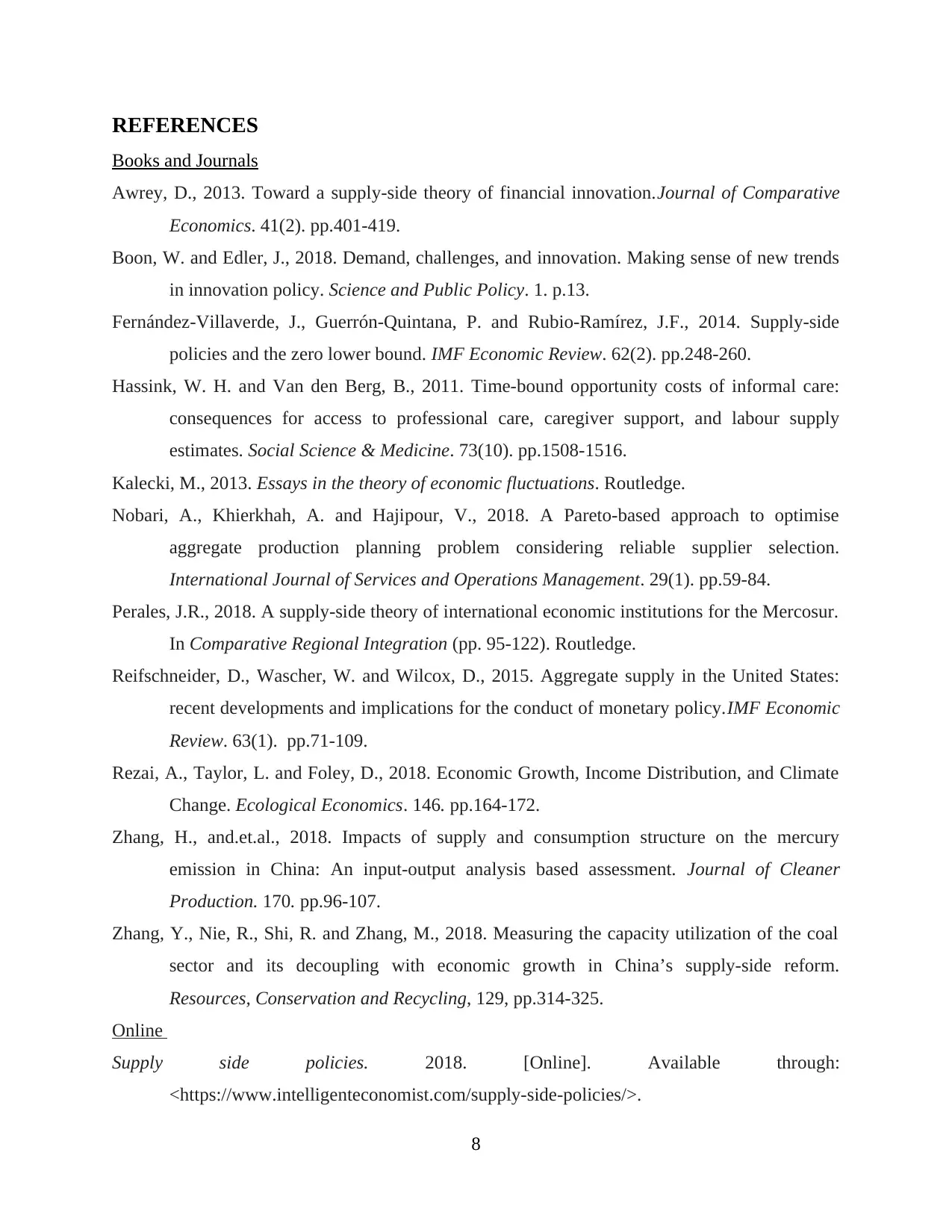
REFERENCES
Books and Journals
Awrey, D., 2013. Toward a supply-side theory of financial innovation.Journal of Comparative
Economics. 41(2). pp.401-419.
Boon, W. and Edler, J., 2018. Demand, challenges, and innovation. Making sense of new trends
in innovation policy. Science and Public Policy. 1. p.13.
Fernández-Villaverde, J., Guerrón-Quintana, P. and Rubio-Ramírez, J.F., 2014. Supply-side
policies and the zero lower bound. IMF Economic Review. 62(2). pp.248-260.
Hassink, W. H. and Van den Berg, B., 2011. Time-bound opportunity costs of informal care:
consequences for access to professional care, caregiver support, and labour supply
estimates. Social Science & Medicine. 73(10). pp.1508-1516.
Kalecki, M., 2013. Essays in the theory of economic fluctuations. Routledge.
Nobari, A., Khierkhah, A. and Hajipour, V., 2018. A Pareto-based approach to optimise
aggregate production planning problem considering reliable supplier selection.
International Journal of Services and Operations Management. 29(1). pp.59-84.
Perales, J.R., 2018. A supply-side theory of international economic institutions for the Mercosur.
In Comparative Regional Integration (pp. 95-122). Routledge.
Reifschneider, D., Wascher, W. and Wilcox, D., 2015. Aggregate supply in the United States:
recent developments and implications for the conduct of monetary policy.IMF Economic
Review. 63(1). pp.71-109.
Rezai, A., Taylor, L. and Foley, D., 2018. Economic Growth, Income Distribution, and Climate
Change. Ecological Economics. 146. pp.164-172.
Zhang, H., and.et.al., 2018. Impacts of supply and consumption structure on the mercury
emission in China: An input-output analysis based assessment. Journal of Cleaner
Production. 170. pp.96-107.
Zhang, Y., Nie, R., Shi, R. and Zhang, M., 2018. Measuring the capacity utilization of the coal
sector and its decoupling with economic growth in China’s supply-side reform.
Resources, Conservation and Recycling, 129, pp.314-325.
Online
Supply side policies. 2018. [Online]. Available through:
<https://www.intelligenteconomist.com/supply-side-policies/>.
8
Books and Journals
Awrey, D., 2013. Toward a supply-side theory of financial innovation.Journal of Comparative
Economics. 41(2). pp.401-419.
Boon, W. and Edler, J., 2018. Demand, challenges, and innovation. Making sense of new trends
in innovation policy. Science and Public Policy. 1. p.13.
Fernández-Villaverde, J., Guerrón-Quintana, P. and Rubio-Ramírez, J.F., 2014. Supply-side
policies and the zero lower bound. IMF Economic Review. 62(2). pp.248-260.
Hassink, W. H. and Van den Berg, B., 2011. Time-bound opportunity costs of informal care:
consequences for access to professional care, caregiver support, and labour supply
estimates. Social Science & Medicine. 73(10). pp.1508-1516.
Kalecki, M., 2013. Essays in the theory of economic fluctuations. Routledge.
Nobari, A., Khierkhah, A. and Hajipour, V., 2018. A Pareto-based approach to optimise
aggregate production planning problem considering reliable supplier selection.
International Journal of Services and Operations Management. 29(1). pp.59-84.
Perales, J.R., 2018. A supply-side theory of international economic institutions for the Mercosur.
In Comparative Regional Integration (pp. 95-122). Routledge.
Reifschneider, D., Wascher, W. and Wilcox, D., 2015. Aggregate supply in the United States:
recent developments and implications for the conduct of monetary policy.IMF Economic
Review. 63(1). pp.71-109.
Rezai, A., Taylor, L. and Foley, D., 2018. Economic Growth, Income Distribution, and Climate
Change. Ecological Economics. 146. pp.164-172.
Zhang, H., and.et.al., 2018. Impacts of supply and consumption structure on the mercury
emission in China: An input-output analysis based assessment. Journal of Cleaner
Production. 170. pp.96-107.
Zhang, Y., Nie, R., Shi, R. and Zhang, M., 2018. Measuring the capacity utilization of the coal
sector and its decoupling with economic growth in China’s supply-side reform.
Resources, Conservation and Recycling, 129, pp.314-325.
Online
Supply side policies. 2018. [Online]. Available through:
<https://www.intelligenteconomist.com/supply-side-policies/>.
8
Paraphrase This Document
Need a fresh take? Get an instant paraphrase of this document with our AI Paraphraser
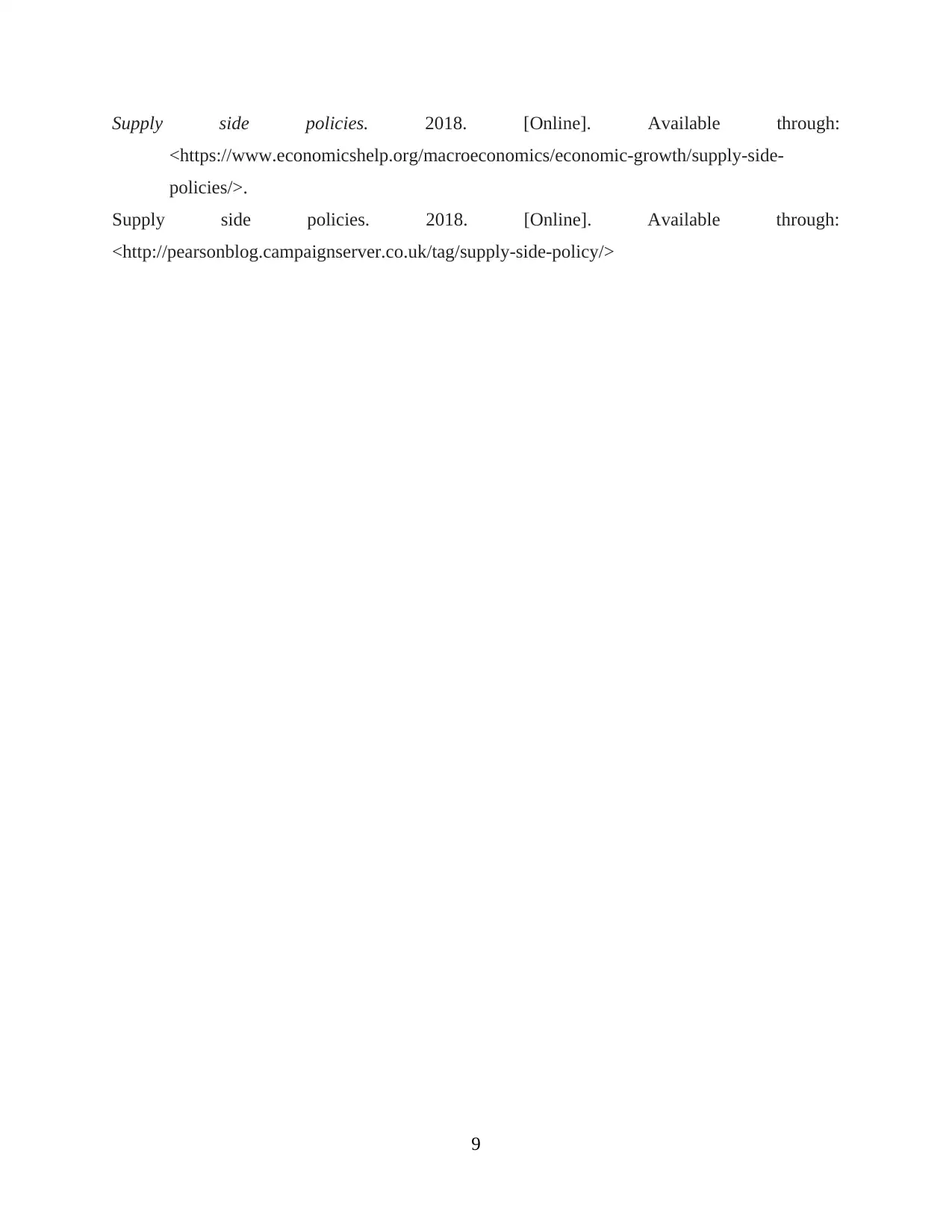
Supply side policies. 2018. [Online]. Available through:
<https://www.economicshelp.org/macroeconomics/economic-growth/supply-side-
policies/>.
Supply side policies. 2018. [Online]. Available through:
<http://pearsonblog.campaignserver.co.uk/tag/supply-side-policy/>
9
<https://www.economicshelp.org/macroeconomics/economic-growth/supply-side-
policies/>.
Supply side policies. 2018. [Online]. Available through:
<http://pearsonblog.campaignserver.co.uk/tag/supply-side-policy/>
9
1 out of 11
Related Documents
Your All-in-One AI-Powered Toolkit for Academic Success.
+13062052269
info@desklib.com
Available 24*7 on WhatsApp / Email
![[object Object]](/_next/static/media/star-bottom.7253800d.svg)
Unlock your academic potential
Copyright © 2020–2025 A2Z Services. All Rights Reserved. Developed and managed by ZUCOL.





